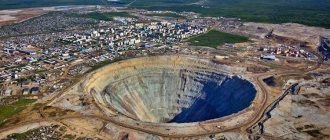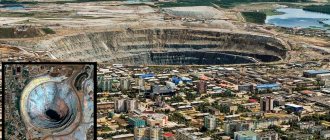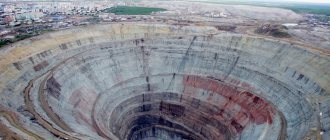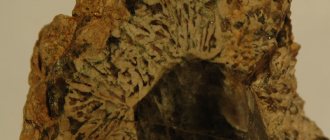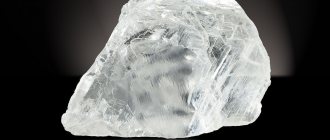Not everyone has ever heard of such a rather rare phrase as “kimberlite pipe”. Even those who say that these words are familiar to them, it is still not a fact that they will be able to answer the question of what it is. However, this is what stands at the origins of the jewelry industry, and what we call diamonds. These minerals are mined from huge “holes” in the ground, just looking at which you stop treating the word “pipe” as something small and almost toy. The history of this phrase originates in Africa, and this method of diamond mining is truly amazing in its scale and how many people keep the mines running. Let's figure out what it is and why entire cities are often built around such deposits. Believe me, the scale will impress you and you will have something to discuss with your friends. And at the same time I’ll tell you what happens to these giants when you can no longer dig them.
The dimensions of kimberlite pipes are enormous.
What is a kimberlite pipe
First of all, you need to understand that a kimberlite pipe is not some small object that lies in the ground or is a geologist’s tool, but a full-fledged geological body. This is the customary name for formations in the earth’s crust that have certain specific properties or are of scientific and commercial interest.
A kimberlite pipe is usually called a vertical or at least close to vertical geological body that is formed when magma breaks through the earth’s crust. The pipe itself is filled with kimberlite . Logical, right?
Who is the Tully Monster and who owns the mysterious fossil remains?
This is exactly what the rock and the pipe itself are called because of the historical features of the discovery of such geological bodies. This first happened in South Africa near the city of Kimberley. Since then, no matter where such a pipe is located, it is always called kimberlite.
This is what the first kimberlite pipe in the Kimberley looks like now.
Such a geological body is called a pipe due to the fact that it is really elongated and goes into the ground like a pipe. Considering the peculiarities of geological processes, its size is enormous. The kimberlite pipe reaches a diameter of 400-1000 meters . Sometimes its dimensions even exceed these values. Essentially, this is a channel through which gases and molten magma passed in ancient times.
"Russian Maldives", Novosibirsk region
Not far from Novosibirsk there is an ash dump of CHPP-5, which a couple of years ago became a star on social networks - local residents and tourists poured into the flooded dump to take photos in the bright blue water. This place was nicknamed the “Russian Maldives”; it was so popular that the authorities had to take action - the water in the ash dump is aggressive in its composition. The color comes from ash and slag, which remain after burning coal at a thermal power plant.
Photo: Alexander Kryazhev / RIA Novosti
The question of how to make the dump a tourist site was discussed; they wanted to create gazebos and photo zones there, but so far this decision has not been made.
What's inside a kimberlite pipe?
Externally, the rock that is found in a kimberlite pipe consists of volcanic fragments, a tuff-like mass of greenish-gray color and minerals distributed throughout it. The tuff-like mass is based on substances such as xenoliths, phlogopite, olivine, carbonates, pyrope and other minerals.
Could microbes mine minerals on Mars?
The most important thing that drives the development of kimberlite pipes is diamonds. It is these small stones that are worth dragging millions of tons of rock from place to place with quarry trucks. After processing the diamonds, diamonds are obtained. Not long ago I already talked about how diamonds are mined, how they are processed and gave examples of the largest and most expensive of them. Then the article found a great response among the participants in our Telegram chat and they asked to tell us more about kimberlite pipes.
Everywhere you look, there is a pipe. Notice that there is a stadium in the photo and appreciate its size against the background of this huge hole.
There are about 1,500 kimberlite pipes in the world , but not all of them make sense to be developed, since only a tenth of them are diamond-bearing. Most of them are unprofitable, and the most useful from the point of view of “exhaust” are located in South Africa, India and Yakutia on the Central Siberian platform.
It is interesting that the first kimberlite pipe in Yakutia was discovered not by a bearded geologist, but by a woman, Larisa Popugaeva. This happened on August 21, 1954. It was called “Zarnitsa”.
A kimberlite pipe is a large column that expands near the surface and narrows at depth. In fact, these are echoes of ancient volcanoes. At the moment, their upper part is destroyed due to erosion processes, but the base and kimberlite pipes have been preserved. That is, many millions of years ago these places were not so quiet and peaceful. But it was then that the Earth shared with us diamonds, which are formed only at great depths under pressure thousands of times greater than atmospheric pressure. Now all we have to do is collect them. Of course, if the word “only” is applicable to such a titanic amount of work.
Here is such a volumetric model.
If you have diamonds at home, look at them and realize that they were at a depth of tens of kilometers from the surface of the Earth, were under pressure of thousands of atmospheres and spent tens and hundreds of millions of years in this state. Now they are used in decorations. These are real messengers from the past who have come a long way to make a ring, earring or necklace. This is much cooler than meteorites.
White Well, Voronezh Region
This place is both similar and different from Konduki. Clay was mined here, and the part where production stopped was flooded with water. When viewed from the inside, the White Well is a bit like the Grand Canyon in the USA, with the difference that the walls of this canyon are white - hence the name. The lowland is heavily overgrown with reeds and sea buckthorn.
White well
Photo: Oleg Kharseev / Kommersant
The area of the well is well-equipped and inhabited - there is a fee to enter there, there is a beach, you can swim and fish, stay at a campsite, have a barbecue in a local cafe or hold a corporate event. Music festivals and other cultural and sporting events are also held here.
How to develop a kimberlite pipe
To develop a kimberlite pipe, a funnel-shaped hole is gradually made in the ground, the depth of which reaches 600-700 meters, and the diameter of the upper part is often comparable to the size of a small town . When open-pit mining becomes impossible, shafts are drilled around the “funnel” to a depth of up to a kilometer (and sometimes more).
How diamonds are mined and where they come from.
Mining continues through these mines as long as it remains profitable and as long as the minerals found in the rock can be sold for more money than they spent on mining. If the trend becomes reversed and the balance is negative, attempts will be made to additionally search for minerals away from the sinkhole and mining will gradually cease .
There are a lot of names of mines and tunnels around the tube, but they are not so important. The spatial structure is enough to understand what is happening there.
To process the rock, a mining and processing plant is being built near the mining site, and a whole city is being built for the miners to live in, which will have all the infrastructure, entertainment and even an airfield. Often such places can only be reached by air.
I talked about how mining and processing plants work and how diamonds are processed in this article.
Deposit development is often carried out using explosions. This is the most reliable, safe and inexpensive method, since even quarry excavators cannot pull such a volume of rock. Explosives are placed inside the rock, after which it is collapsed and hauled away in huge quarry trucks to “extract the diamonds from it.”
Compared to the scale of the quarry, trucks seem tiny, but in fact they can crush a car or pickup truck and not even notice it (there have been cases)
Konduki, Tula region
The Konduks, or Romantsevskie Mountains, are one of the most famous examples of landscapes in Russia that were created by the hands of man (and the buckets of his graders). Previously, there were Ushakovsky quarries of the Moscow region coal basin - coal was mined until 1996, and the rock was dumped in heaps. This is how mountains up to 40 meters high appeared, and quarries up to 80 meters deep were filled with water, which turned bright blue, which, with good lighting, takes on a turquoise hue.
Conduki
Photo: Yuliy Akhromeev / RIA Novosti
The result is a fantastic, alien landscape in the middle of the Russian steppe, which can be seen for many kilometers from the tops of the Romantsevsky Mountains. Soon they decided to set up a recreational complex here, the territory became especially protected, work began to strengthen the cliffs, and a huge inscription “Konduki” appeared. You can get to the complex by any car - there is a tolerable road leading to it.
The largest kimberlite pipe in Russia
The largest deposit in Russia is Mir, which is located in Yakutia. there from 1957 to 2001 . The subsoil user is Alrosa, and the volume of ore processed during this time amounted to 68 million tons. Now this kimberlite pipe is no longer “working” and mining there has been stopped, but it was there that the largest diamonds were mined back in Soviet times, which deservedly took their place in the ranking of the largest.
Kimberlite pipe The world is simply huge.
Despite the high level of automation of the process, many people still have to be involved in mining. Perhaps in the near future, to ensure the operation of such objects, a couple of people will be needed at a computer, but this will not happen soon, and it is unlikely that anyone will come up with a working method for mining as efficient as the open method.
Ruskeala, Karelia
Ruskeala is a quarry in northern Russia, which began to be developed under Catherine II, in 1765. They mined here multi-colored marble (for example, the one with which St. Isaac's Cathedral in St. Petersburg is faced), and, of course, there were no jackhammers or other complex equipment then, so they did it with the help of explosions. This is how a quarry with a length of almost half a kilometer appeared; several kilometers of tunnels and adits were hidden from view, which were flooded in the second half of the 20th century.
Ruskeala
Photo: Ruslan Shamukov / TASS
Now Ruskeala is recognized as a historical monument and cultural heritage site, and a tourist complex has been built around the quarry. Since 2022, a retro steam-powered train, the Ruskeala Express, has been running there. Films are made in the quarry and festivals are held.
Phosphogypsum Mountain, Moscow region
Another picturesque place near Moscow is White Mountain, six kilometers from Voskresensk. In fact, this is a compacted embankment made of phosphogypsum, which appeared as a result of the work of the Voskresensk mineral fertilizer plant.
Phosphogypsum mountain
Photo: bbsferrari / Depositphotos
Phosphogypsum is a by-product of the production of fertilizers using phosphate rock and sulfuric acid, but unlike them it is safe.
From a distance, the mound looks like a bizarre mountain plateau covered with snow, and if you get close, you can see something reminiscent of salt fields, like in Turkey or Vietnam.
Shipunovsky marble quarry, Novosibirsk region
This quarry is not as huge as its competitors, but its quirky shape will definitely appeal to industrial tourists and lovers of abandoned places. It looks like the steps of an amphitheater, the bottom of which is filled with water.
Shipunovsky marble quarry
Shot: Maxim Demin / YouTube
Once upon a time, marble was mined here for facing slabs, but in the 1990s, limestone began to be mined not far from the quarry, and for this they carried out blasting operations. Because of these explosions, the marble became covered with cracks and became of no use to anyone. So the bizarre marble amphitheater began to gradually collapse and be overgrown with trees breaking through the stone.
PS: Kola superdeep well, Murmansk region
The Kola Superdeep is the deepest scar that people have left on the body of the planet. Shrouded in urban legends about scientists who dug to hell, the well goes more than 12 kilometers deep.
The mouth of the Kola superdeep well in 2012
Photo: Wikipedia
However, it is a sad sight and is located literally on the edge of the earth, in a restricted area, where you need to obtain a pass in advance. Nevertheless, those who want to touch history still meet, but only a metal plug awaits them in the middle of the ruins of a once advanced experimental drilling complex.
